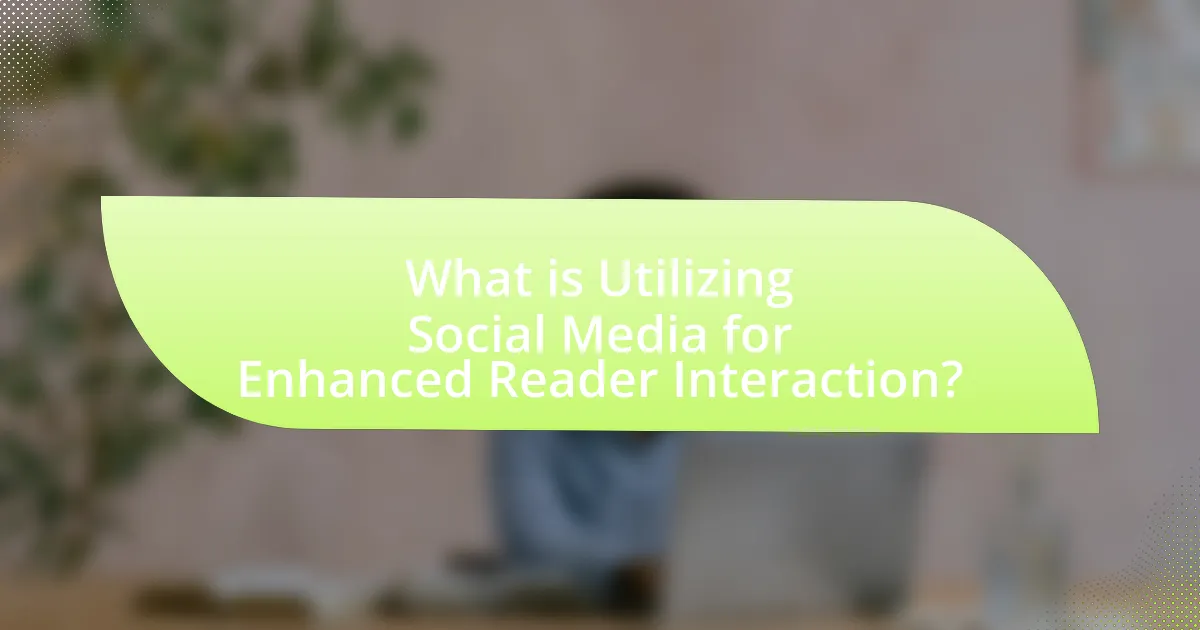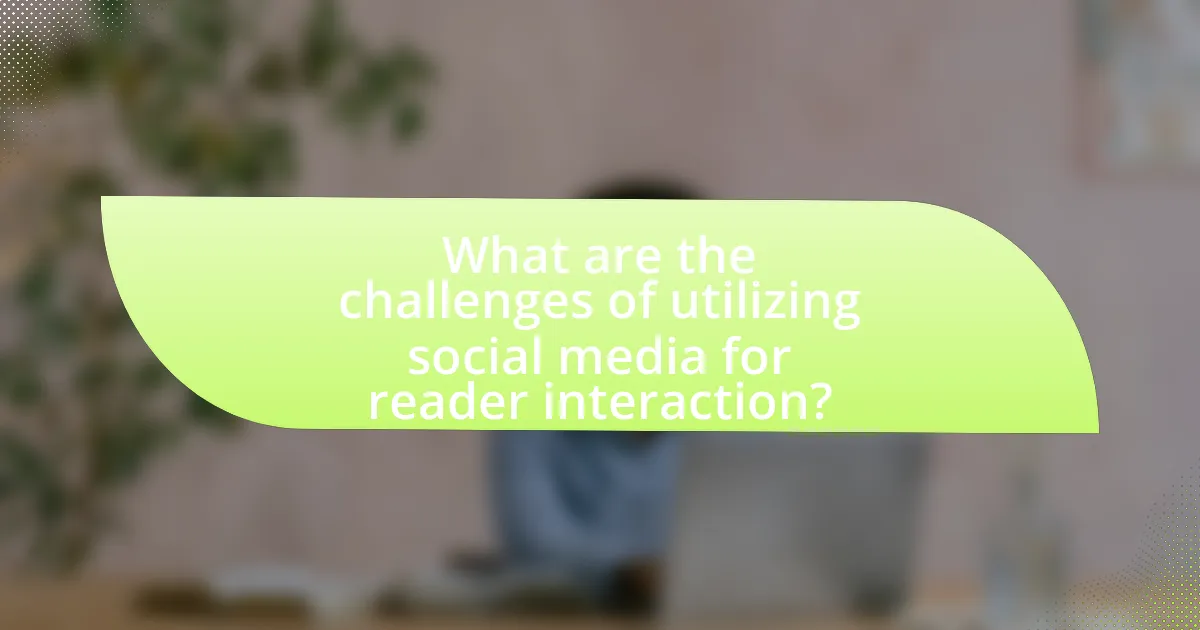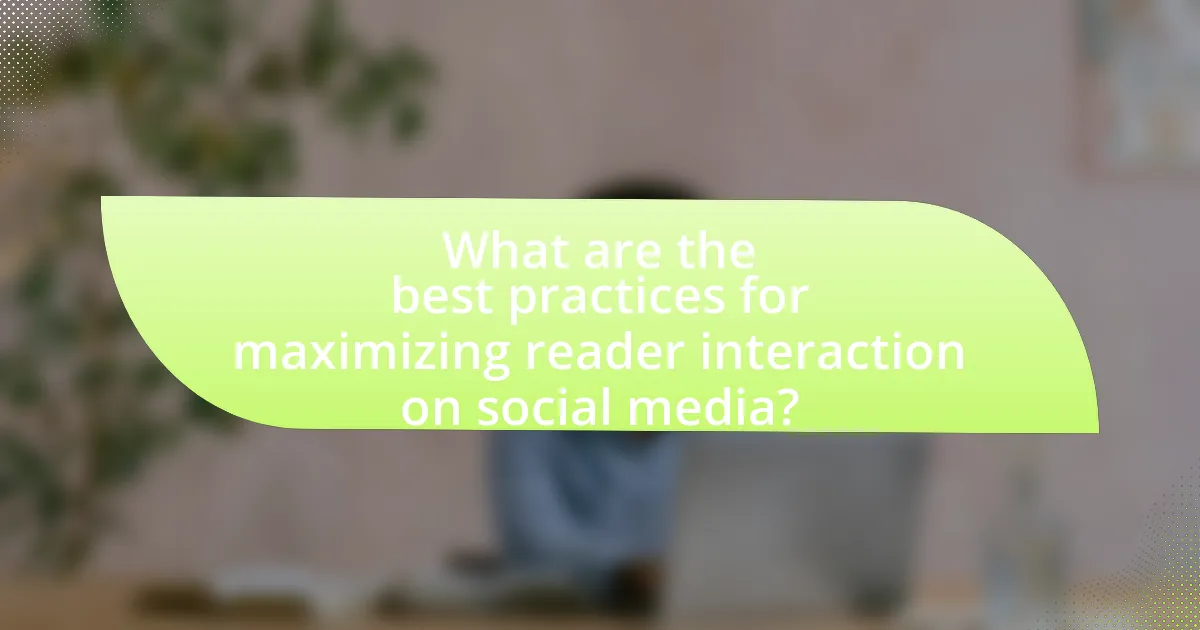Utilizing social media for enhanced reader interaction involves leveraging platforms such as Facebook, Twitter, and Instagram to engage audiences and foster community dialogue. The article explores how social media facilitates real-time communication, the effectiveness of various platforms for reader engagement, and the importance of reader interaction in today’s digital landscape. It also discusses strategies for enhancing interaction, the role of analytics in shaping content strategies, and the challenges content creators face in maintaining engagement. Key metrics for assessing reader engagement and best practices for maximizing interaction are highlighted, providing a comprehensive overview of effective social media utilization for content creators.

What is Utilizing Social Media for Enhanced Reader Interaction?
Utilizing social media for enhanced reader interaction involves leveraging platforms like Facebook, Twitter, and Instagram to engage audiences directly and foster community dialogue. This approach allows content creators to share updates, solicit feedback, and create discussions around their work, thereby increasing reader loyalty and participation. Research indicates that 70% of consumers feel more connected to brands that engage with them on social media, highlighting the effectiveness of this strategy in building relationships and enhancing reader experience.
How does social media facilitate reader interaction?
Social media facilitates reader interaction by providing platforms for real-time communication and engagement between content creators and their audiences. These platforms, such as Facebook, Twitter, and Instagram, allow readers to comment, share, and react to content instantly, fostering a sense of community and dialogue. For instance, a study by the Pew Research Center found that 69% of adults in the U.S. use social media, which enhances the likelihood of interaction through likes, shares, and comments, thereby increasing reader engagement and feedback.
What platforms are most effective for reader engagement?
Social media platforms such as Facebook, Instagram, Twitter, and LinkedIn are most effective for reader engagement. These platforms facilitate direct interaction between content creators and their audience, allowing for real-time feedback and discussions. For instance, a study by the Pew Research Center found that 69% of adults in the U.S. use Facebook, making it a prime platform for reaching a broad audience and fostering engagement through comments, shares, and reactions. Additionally, Instagram’s visual content encourages higher interaction rates, with posts receiving an average engagement rate of 1.22% compared to Facebook’s 0.08%. Twitter’s fast-paced environment allows for quick updates and conversations, while LinkedIn is effective for professional engagement and networking. These statistics demonstrate that leveraging these platforms can significantly enhance reader interaction.
How do different demographics interact on social media?
Different demographics interact on social media through varying platforms and content types, influenced by age, gender, and cultural background. For instance, younger users, particularly those aged 18-29, predominantly engage on platforms like Instagram and TikTok, favoring visual content such as videos and stories. In contrast, older demographics, especially those over 50, tend to prefer Facebook for its community-oriented features and news sharing. Gender differences also play a role; studies show that women are more likely to use social media for connection and community, while men often engage in discussions and gaming-related content. According to the Pew Research Center, 69% of adults in the U.S. use social media, with usage patterns reflecting these demographic distinctions, highlighting how different groups tailor their interactions based on platform preferences and content engagement styles.
Why is reader interaction important in today’s digital landscape?
Reader interaction is crucial in today’s digital landscape because it fosters engagement, builds community, and enhances content relevance. Engaged readers are more likely to share content, which increases visibility and reach; for instance, studies show that content shared on social media can lead to a 24% increase in traffic. Additionally, interaction allows creators to receive immediate feedback, enabling them to tailor their content to audience preferences, thus improving user satisfaction and retention. This dynamic relationship between content creators and readers ultimately drives brand loyalty and encourages ongoing dialogue, making reader interaction a key component of successful digital strategies.
What impact does reader interaction have on content visibility?
Reader interaction significantly enhances content visibility by increasing engagement metrics such as shares, comments, and likes. These interactions signal to algorithms on platforms like Facebook and Twitter that the content is valuable, leading to higher rankings in feeds and greater exposure to a wider audience. For instance, a study by BuzzSumo found that content with higher engagement rates received 8 times more shares than those with minimal interaction, demonstrating a direct correlation between reader engagement and visibility.
How does enhanced interaction influence reader loyalty?
Enhanced interaction significantly boosts reader loyalty by fostering a sense of community and engagement. When readers actively participate through comments, shares, and discussions on social media platforms, they feel more connected to the content and the creators. This connection leads to increased trust and emotional investment in the material, which is crucial for loyalty. Research indicates that 70% of consumers feel more loyal to brands that engage with them on social media, highlighting the importance of interaction in building lasting relationships.
What strategies can be employed to enhance reader interaction on social media?
To enhance reader interaction on social media, employing strategies such as creating engaging content, utilizing interactive features, and fostering community involvement is essential. Engaging content, including polls, quizzes, and visually appealing posts, captures attention and encourages participation. Interactive features like live videos and Q&A sessions allow real-time engagement, making readers feel valued and heard. Additionally, fostering community involvement through user-generated content and responding promptly to comments builds a sense of belonging and loyalty among followers. Research indicates that posts with interactive elements can increase engagement rates by up to 50%, demonstrating the effectiveness of these strategies in enhancing reader interaction.
How can content creators utilize polls and questions effectively?
Content creators can utilize polls and questions effectively by engaging their audience to gather insights and foster interaction. By incorporating polls, creators can quickly assess audience preferences, which can inform content direction and enhance relevance. For instance, a study by Sprout Social found that 70% of consumers feel more connected to brands that engage with them on social media, highlighting the importance of interaction. Additionally, asking open-ended questions encourages deeper conversations, allowing creators to understand their audience’s needs and interests better. This two-way communication not only builds community but also increases audience loyalty, as evidenced by research from HubSpot, which indicates that brands that prioritize customer engagement see a 63% increase in customer retention.
What role do visuals play in engaging readers on social media?
Visuals play a crucial role in engaging readers on social media by capturing attention and enhancing message retention. Research indicates that posts with images receive 94% more views than those without, demonstrating that visuals significantly increase user interaction. Additionally, studies show that people process visuals 60,000 times faster than text, which means that effective imagery can convey complex ideas quickly and effectively, leading to higher engagement rates.
How can analytics improve reader interaction strategies?
Analytics can improve reader interaction strategies by providing insights into reader behavior and preferences. By analyzing data such as engagement rates, click-through rates, and demographic information, content creators can tailor their strategies to better meet the needs and interests of their audience. For instance, a study by HubSpot found that personalized content can increase engagement by up to 202%. This data-driven approach allows for the optimization of content delivery times, formats, and topics, ultimately enhancing the overall reader experience and fostering stronger connections between the audience and the content.
What metrics should be monitored to assess reader engagement?
To assess reader engagement, key metrics to monitor include page views, time spent on page, bounce rate, social shares, comments, and click-through rates. Page views indicate the volume of traffic, while time spent on page reflects the depth of engagement. A high bounce rate suggests that readers are not finding the content relevant, whereas social shares and comments demonstrate active participation and interest. Click-through rates reveal how effectively content drives readers to take further action. These metrics collectively provide a comprehensive view of reader engagement levels.
How can feedback from analytics shape future content strategies?
Feedback from analytics can significantly shape future content strategies by providing data-driven insights into audience preferences and engagement patterns. By analyzing metrics such as page views, social shares, and user interactions, content creators can identify which topics resonate most with their audience. For instance, a study by HubSpot found that content tailored to audience interests can increase engagement rates by up to 300%. This data allows marketers to refine their content focus, optimize posting times, and enhance overall content quality, ensuring that future strategies align closely with audience expectations and behaviors.

What are the challenges of utilizing social media for reader interaction?
Utilizing social media for reader interaction presents several challenges, including managing negative feedback, ensuring consistent engagement, and navigating platform algorithms. Negative feedback can deter potential readers and damage a brand’s reputation, as studies show that 70% of consumers trust online reviews as much as personal recommendations. Consistent engagement is difficult due to the fast-paced nature of social media, where content can quickly become irrelevant, leading to decreased interaction rates. Additionally, platform algorithms often limit the visibility of posts, making it challenging for content to reach the intended audience; for instance, Facebook’s algorithm prioritizes posts from friends and family over brands, which can significantly reduce organic reach.
What common pitfalls should content creators avoid?
Content creators should avoid the pitfall of inconsistent posting schedules. Inconsistent posting can lead to decreased audience engagement, as followers may lose interest or forget about the content creator. Research indicates that brands that post consistently can see up to 67% more engagement compared to those that do not. Additionally, content creators should avoid neglecting audience feedback; ignoring comments and messages can alienate followers and diminish community building. Engaging with the audience fosters loyalty and encourages interaction, which is crucial for utilizing social media effectively.
How can negative feedback be managed effectively?
Negative feedback can be managed effectively by actively listening to the concerns raised, responding promptly, and implementing changes based on the feedback. Engaging with the audience through social media platforms allows for real-time communication, which can help clarify misunderstandings and demonstrate a commitment to improvement. Research indicates that companies that respond to negative feedback on social media can increase customer loyalty by up to 25%, as it shows that they value customer input and are willing to make adjustments.
What are the risks of over-promoting content on social media?
Over-promoting content on social media can lead to audience fatigue, decreased engagement, and potential damage to brand reputation. When users are bombarded with excessive promotional posts, they may become annoyed and disengage from the brand, resulting in lower interaction rates. A study by HubSpot found that 54% of consumers prefer brands that share a mix of promotional and non-promotional content, indicating that balance is crucial for maintaining audience interest. Additionally, over-promotion can lead to negative perceptions of the brand, as users may view it as spammy or insincere, which can ultimately harm customer loyalty and trust.
How can one maintain authenticity while engaging readers?
To maintain authenticity while engaging readers, one should consistently share personal experiences and insights that resonate with their audience. Authenticity is achieved when content reflects genuine thoughts and emotions, fostering a connection with readers. For instance, studies show that 86% of consumers value authenticity in brands, indicating that relatable and honest communication enhances reader trust and engagement. By being transparent and open about one’s journey, challenges, and successes, a creator can cultivate a loyal readership that feels connected to the content on a deeper level.
What strategies promote genuine interactions with readers?
Strategies that promote genuine interactions with readers include actively engaging with their comments, personalizing responses, and creating interactive content. Engaging with comments fosters a sense of community and shows readers that their opinions are valued. Personalizing responses, such as addressing readers by name or referencing their specific comments, enhances the connection and makes interactions feel more meaningful. Creating interactive content, like polls or Q&A sessions, encourages participation and allows readers to feel involved in the conversation. Research indicates that personalized communication can increase engagement rates by up to 50%, demonstrating the effectiveness of these strategies in fostering genuine reader interactions.
How can transparency build trust with the audience?
Transparency builds trust with the audience by fostering open communication and accountability. When organizations share information about their processes, decisions, and values, they create an environment where the audience feels informed and valued. Research indicates that 81% of consumers need to trust a brand before making a purchase, highlighting the importance of transparency in consumer relationships. By being honest about challenges and successes, organizations can demonstrate reliability and integrity, which are crucial for establishing long-term trust.

What are the best practices for maximizing reader interaction on social media?
To maximize reader interaction on social media, consistently create engaging and relevant content tailored to your audience’s interests. Engaging content includes visuals, polls, and questions that encourage responses. For instance, posts with images receive 94% more views than text-only posts, highlighting the importance of visual elements. Additionally, utilizing analytics tools to track engagement metrics allows for data-driven adjustments to content strategies, ensuring alignment with audience preferences. Regularly responding to comments and messages fosters a sense of community, further enhancing interaction.
How can content be tailored to different social media platforms?
Content can be tailored to different social media platforms by adapting the format, tone, and messaging to fit the unique characteristics and audience preferences of each platform. For instance, Instagram favors visually appealing images and short captions, while Twitter requires concise text due to its character limit, making it ideal for quick updates and engaging conversations. Facebook allows for longer posts and a mix of media, which can include articles, videos, and images, catering to a more diverse audience. LinkedIn focuses on professional content, emphasizing industry insights and networking opportunities. Research shows that posts optimized for specific platforms can increase engagement rates significantly; for example, images on Instagram can lead to a 650% higher engagement rate compared to text-only posts.
What types of content resonate best with audiences on various platforms?
Visual content, such as images and videos, resonates best with audiences on platforms like Instagram and TikTok. Research indicates that posts with visuals receive 94% more views than those without, highlighting the effectiveness of engaging imagery. Additionally, short-form videos, particularly on TikTok, have shown to increase user engagement significantly, with 67% of users reporting a higher likelihood of sharing video content. On platforms like Facebook and Twitter, informative articles and infographics perform well, as they provide value and encourage sharing among users. Data from BuzzSumo shows that articles with compelling headlines and relevant images receive 50% more social shares than text-only posts.
How often should content be posted to maintain engagement?
To maintain engagement, content should be posted at least three to five times per week. This frequency has been shown to optimize audience interaction and visibility on social media platforms. According to a study by HubSpot, brands that post consistently see a 50% increase in engagement compared to those that post less frequently. Additionally, research from Sprout Social indicates that posting daily can further enhance engagement rates, as it keeps the audience consistently informed and connected.
What tools can assist in enhancing reader interaction?
Tools that can assist in enhancing reader interaction include social media platforms, interactive content tools, and analytics software. Social media platforms like Facebook, Twitter, and Instagram enable direct communication and engagement with readers through comments, shares, and likes, fostering a community around content. Interactive content tools, such as quizzes, polls, and surveys, encourage active participation from readers, making the experience more engaging. Analytics software, like Google Analytics and social media insights, provides data on reader behavior, allowing content creators to tailor their strategies to better meet audience preferences and increase interaction.
Which social media management tools are most effective?
The most effective social media management tools include Hootsuite, Buffer, and Sprout Social. Hootsuite allows users to manage multiple social media accounts from one dashboard, schedule posts, and analyze performance metrics, making it a comprehensive tool for engagement. Buffer offers a user-friendly interface for scheduling posts and provides analytics to optimize content strategy. Sprout Social combines social media management with robust analytics and customer relationship management features, enabling businesses to enhance reader interaction effectively. These tools are widely recognized for their capabilities, with Hootsuite serving over 18 million users and Buffer reporting over 75,000 customers, demonstrating their effectiveness in the market.
How can automation be used without losing personal touch?
Automation can be used without losing personal touch by implementing personalized messaging and tailored content delivery. For instance, social media platforms allow businesses to automate responses while still using customer names and previous interactions to create a more engaging experience. Research shows that 70% of consumers prefer personalized experiences, indicating that when automation is combined with data-driven insights, it enhances user satisfaction. By utilizing customer relationship management (CRM) tools, companies can segment their audience and send targeted messages that resonate on a personal level, thus maintaining the human element in automated communications.
What practical tips can improve reader interaction on social media?
To improve reader interaction on social media, consistently engage with your audience by responding to comments and messages promptly. This practice fosters a sense of community and encourages more users to participate in discussions. Research shows that brands that actively engage with their audience see a 20-40% increase in interaction rates. Additionally, using interactive content such as polls, quizzes, and live videos can significantly boost engagement, as these formats invite direct participation from users. According to a study by HubSpot, posts that include interactive elements receive 50% more engagement than static posts.
